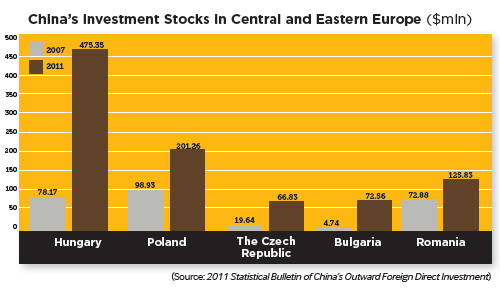|
The slowdown in the growth rate of China's exports is the result of declining competitive advantage. The competitiveness of labor-intensive exports from China has long been in decline in the EU market, and even the competitive advantage of capital-intensive machinery and equipment exports barely exists now. To buck this downward trend, China cannot wait for the EU economy to recover to offset its losses. Instead, it should focus on enhancing the competitiveness of its exports to the EU and moving its products further upstream on the value chain. Speeding up the upgrading of the export industry by increasing investment in Europe has become a new way to compensate for negative growth in China's largest export market, as well as to drive its own economic growth.
Multiple fields
China's investment in infrastructure construction in CEE has maintained a sturdy momentum. The China Road and Bridge Corp. signed a contract with the Serbian Government to build a bridge across the Danube River in April 2010, a landmark project in bilateral cooperation. Chinese information and communications technology companies such as Huawei and ZTE have invested across CEE. China has also accelerated capital and technological investment in hydropower stations, nuclear power plants and thermal power stations in the region. In terms of machinery processing and manufacturing, China has invested in the production lines of electrical appliances, automobiles and heavy machinery in countries such as Hungary, Poland, Bulgaria and Serbia.
At the end of January 2012, Liuzhou-based Liugong Machinery Corp. acquired the Polish construction machinery enterprise HSW, one of the largest such manufacturers in CEE with a highly respected international reputation in the heavy engineering equipment sector. With the acquisition of HSW, Liugong can now extend its influence to the full European market.
As part of its efforts to integrate the above-mentioned competitive industries, China has also strengthened the construction of industrial parks in CEE so as to encourage and expand the influence of Chinese investment in the region. In the future, China will play an increasingly important role in the privatization of large state-owned financial, telecommunications, energy and power companies in CEE countries, acting as a major participant in their pillar industries.
China's main investment approach in CEE is to move its entire industrial chain to the region and build it into a product upgrading as well as a sales center, so as to realize the localization of the production, flow and trade. Nevertheless, investment risks remain. Some members of the European Parliament have stated that China will be welcomed if its investment provides employment opportunities and profits, but it will be met with strong opposition if it wants only to use CEE as an export base and sales center. Competition between China and some countries in the region cannot be ignored. For example, both Poland and Hungary feature processing industries regarded as the miniatures of China in the EU market.
In addition, China is less familiar with countries in CEE after their political transitions. Since the early 1990s, the priority of these countries has been to consolidate democracy, integrate with the West and join the EU. China is mainly engaged in developing its economy and maintaining social stability. China and these countries used to be close; however, they became estranged from one another due to their different strategic development orientations after the end of the Cold War. There are different languages, cultures, ethnic groups, religions and histories in CEE, creating factors that make it more difficult for China to fully understand the region's investment environment.
The author is an associate research fellow with the Institute of European Studies of the Chinese Academy of Social Sciences
Email us at: yanwei@bjreview.com

| 